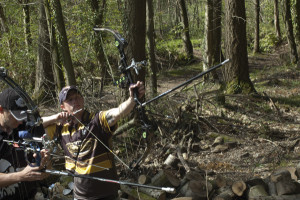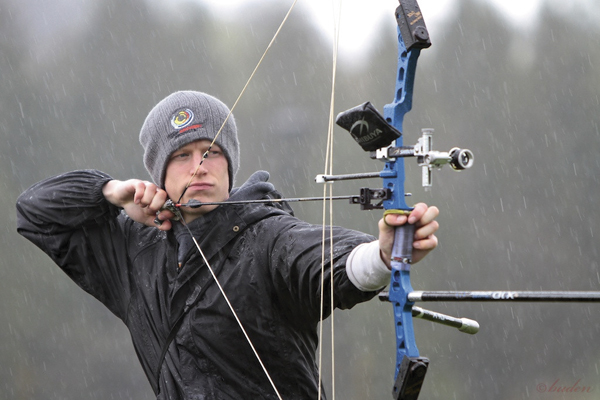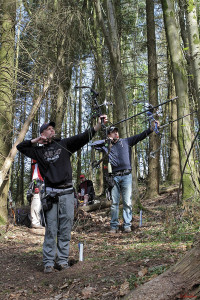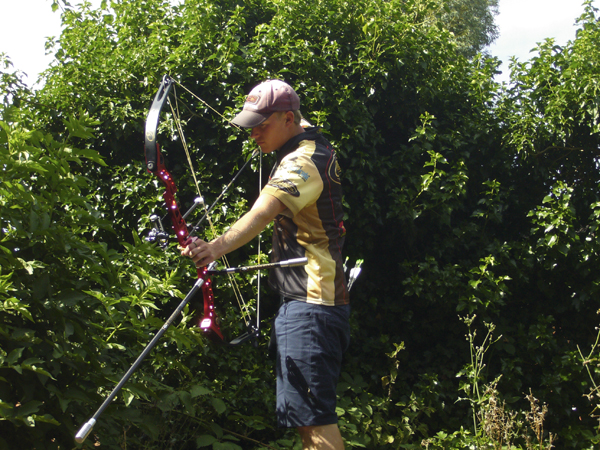Liam Grimwood brings you his top tips to getting a head start in field archery if you’re already an experienced target shot
Now that the outdoor season is here it’s time to give some thought to the type of archery you’ll be doing over the summer. There are a few key points that will help compound target shooters transfer their skills to the slopes ready for their first try at field. I began shooting in 1995 and for years was strictly a target shooter; many of my friends did both field and target, but I was slightly intimidated by field. You hear horror stories of losing arrows, breaking them, and lots of complicated rules, but in 2006 – after more than 10 years as a strict target archer – I went and gave it a go. My first field experience was FITA field, which incorporated half marked and half unmarked targets, and I absolutely loved it. I still probably do more target tournaments than field in an average season, but I absolutely love field and some of my best achievements have been done on the field course.
I have selected some of the most critical points to help you succeed in the transition from target to field:
1. Sight tapes.
Most target shooters get their three or four sight marks required for a given event, scribble them down on a piece of paper and that’s it – done. This method will work fine for target, but for field it just won’t do, and it will catch you out pretty quickly. In actual fact a proper sight tape will be faster to get than a full set of sight marks, and will be more accurate in the long run. This will need some investment, as I would recommend getting a computer program to work out your sight tapes for you. I have used both ‘Accurate Sights’ and ‘Archer’s Advantage’ in the past few years. Accurate Sights is really simple to use and very user friendly, while Archer’s Advantage is a little more complicated, but has more detail, and can help with tuning and arrow selection as well. But if you are focusing purely on sight tapes, they both work great. You will need to take a few simple measurements from your bow, get a 20-metre sight mark and a 70-metre sight mark, plug all this into the program, and it will produce a highly accurate sight tape. You may have to adjust the tape by one or two fps to get it absolutely perfect, but the first one is always pretty close. Having a good sight tape will save you a lot of points out on the course, as it drastically reduces the chance of miss-setting your sight and the possibility of losing your little piece of paper. It also removes all the inaccuracies of five-metre increments, which most people get their marks in. For example, if you only have a 60 and 65 mark and you want to cut one and a half metres off a 65-metre target you might struggle to get it right.

When shooting up and down slopes, third-axis levelling becomes an important part of your preparation
2. Third axis levelling.
I have written a few articles on this over the years, and so have plenty of other archers. Third axis levelling is pretty important, especially if you are planning on shooting up and down slopes. It can be really tough making a good shot on a 45-degree downhill slope, so if you do manage to make a good shot and still get a four because of your third axis it’s pretty frustrating. I use the Hamskea third axis levelling device for this. It comes with easy-to-follow instructions, and on a steep course will save lots of points. A third axis which is set incorrectly will give you extremely bad left and rights as you shoot up and down hills.
3. French tune.
A proper French tune will ensure that as you move up and down distance, your left and right sight adjustment will stay the same. It can be extremely tough if you’re shooting dead centre at 30 metres and 30cm off to the right at 70 metres. There are a number of articles that explain French tuning in more detail, but to simplify it; get your arrows hitting dead centre at 20 metres, then move back to 50 metres and see if your arrows move left or right. If the 50 metre arrows go left, then you need to move your rest position right. Likewise, if your 50 metre arrows go right you need to move your rest left. Keep repeating the process until your left/right stays identical between long and short distance.

French tuning, which will ensure your arrows don’t vary left to right as you move distances, will save you valuable points on a field round
4. Fibre pin.
I would recommend a 0.019” green fibre to use as your aiming device, as this will give you a very fine point to aim with which will be well suited to all face types at all distances. The fibre also brings in more light, so in the dark woods it’s much more visible than a dot. For IFAA rounds, you can also have a light for the fibre making visibility even better, but unfortunately you can’t have one for FITA field, so if you know which discipline you’ll be shooting most of, that’s something to look into.
5. Brightly coloured nocks, wraps, and fletchings.

Arrow wraps, or bright nocks and fletchings, will make it easier to see your arrows in the target, so you can adjust early if you need to
Where possible, brightly-coloured arrows can really help you out, especially if you don’t have the money to splash out on a top-end set of binoculars. Sometimes it can be quite difficult to see where your arrows have gone if it’s dark, so bright arrows will help you to spot them. Spotting your arrows is critical as you can adjust after your first shot should you need to. Even if it’s in the middle, sometimes not knowing where it’s landed can knock your confidence and ruin the next shots, so a bright arrow is a simple fix compared to a set of £1,000 binoculars.
6. Tour guide.
Where possible try and find someone from your club to go with you. There are some different rules in field concerning which peg to shoot off, and which face to shoot at, so going with a friend or club member will help stop you from making any really silly mistakes.
7. Don’t be afraid to give it a try.
It can appear to be quite intimidating at first, but field archery is really enjoyable. I now enjoy it far more than target and get a real sense of achievement from it. It breaks the boredom of just walking backwards and forwards all day and depending on the course you’re at you can see some pretty amazing things. Since competing in field archery I have shot in a World War 1 fort, a valley in the Lake District, an enormous castle in Germany and hanging off a cliff in Brecon. Wherever you are, I guarantee you won’t be disappointed.


